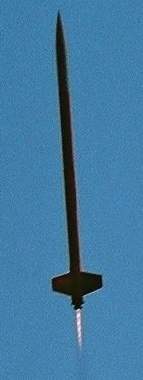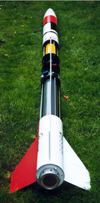HYBRID ROCKET MOTORS
BACKGROUND ON HYBRID ROCKET MOTORS

Figure 1: R.A.T.T.Works I-80H hybrid
rocket motor powering a 54mm
diameter fibreglass rocket.
Note the clearly visible Mach
diamonds in the exhaust.
Photograph by Bob Arnott
Hybrid rocket motors offer a very low cost and safe means of rocket propulsion. Consisting of a solid fuel and a liquid oxidiser (hence the name hybrid since it is a hybrid of a solid rocket motor and a liquid rocket motor), or a liquid fuel and a solid oxidiser (known as a reverse hybrid), often, Hybrid Rocket motors are little more than a single aluminium tube with a floating bulkhead, a nozzle and an end closure, with the oxidiser being released into the combustion chamber containing the fuel, and both being ignited by a pyrovalve.
The more traditional view of a hybrid rocket motor is of a separate combustion chamber and oxidiser tank, joined by plumbing, sometimes with a valve between the combustion chamber and oxidiser tank too. Both the single tube hybrids (known as monotube hybrids) and the separate combustion chamber and oxidiser tank hybrids are seen in High Power Rocketry and Amateur Rocketry.
Hybrid rockets are very straightforward to launch, and with practice, it takes less time to prepare a hybrid propelled rocket for launch than a solid propelled rocket, although because for the unitiatiated it can involve a lot of messing about to launch successfully, observers often form the erroneous impression that the hybrid rocket motor is a lot more complicated than a solid rocket motor -it doesn't need to be.
Hybrid rockets lack the oooomphh of a solid rocket motor, and are less impressive for show launches if lots of flames and smoke are required, e.g. for TV shows, however, their longer burns and much cheaper operating costs bring attractions of their own to rocketeers - especially the longer burning time aspect.
All of the commercially available hybrid rocket motors for the High Power Rocketry and Model Rocketry communities use liquid Nitrous Oxide (N2O) as the oxidiser. Nitrous Oxide is available from sources such as custom car engine modification shops, where it is used for injection into car and motorbike engines for extra power, and from some specialist rocket shops. Nitrous Oxide is not expensive, and to fill an I-class (320 - 640 Newton second total impulse) hybrid rocket motor takes about £3.50 of Nitrous Oxide.
Within the scratch built hybrid rocket motor domain of the amateur rocketry community, other oxidisers are sometimes used, ranging from Hydrogen Peroxide through Liquid Oxygen, Gaseous Oxygen to Nitric Acid.

Figure 2: MARS amateur hybrid
rocket, using a stringer
airframe assembly.
The hybrid motor
combustion chamber is
4 inches (101mm)
diameter.
In order to supply the oxidiser tank in the hybrid rocket motor with Nitrous Oxide, a pressurised cylinder of Nitrous Oxide is required on the ground. This needs to have an electrically actuated solenoid valve fitted to it (to enable remote controlled operations for safety), and a fill line that runs either through an adaptor to a plastic disposable fill hose to the oxidiser tank of the hybrid rocket, or runs into an umbilical release mechanism attached to the oxidiser tank.
Generally, high power rocketry hybrid rocket motors use the disposable plastic hose fill method, and larger more complex, scratch built amateur hybrid rockets use an umbilical release system.
The fill line allows the Nitrous Oxide to flow from the pressurised cylinder on the ground to the oxidiser tank in the hybrid rocket motor. The electrically actuated solenoid valve is switched on via a remote launch control box, to allow Nitrous Oxide to flow to the hybrid motor's oxidiser tank onboard the rocket, and switched off to shut off the supply of Nitrous Oxide to the oxidiser tank. Normally, the solenoid valve will be controlled from a secondary 12 volt output from a launch controller.
The fuel grain used in hybrid rocket motors can be any material that burns in an oxygen rich environment - this allows pretty much anything to be used as the fuel, although normally polyethylene or acrylic is used. On the microhybrid, cardboard is used as a fuel as well as acrylic and polyethylene. hybrid rocket motors have even been runfor ground tests using Salami as the fuel!
The commercially available hybrid rocket motors for the High Power Rocketry and Model Rocketry communities range from 20 Newton seconds total impulse(D-class) to 30,000 Newton seconds total impulse (O-class). The main hybrid rocket motor manufacturers within the High Power Rocketry and Model Rocketry communities are Hypertek, R.A.T.T.Works, Skyripper, Contrail, West Coast Hybrids, Aerotech, Propulsion Polymers and Microhybrid.
Note: Figures current as of October, 2007.
For more hybrid information on this website, the following web pages may be of interest:
- Hybrid Science
- Hybrid Rocket Help Clinic
- Hybrid Rocket History in the UK
- Hybrid Rocket Motor Costs
- Hybrid Rocket Motors in the UK
- Hybrid Rocket Links
Availability:
Currently, all brands of hybrid rocket motor are available direct from the U.S. manufacturers or via their U.K. distributor, Uncle Bob's Rocket Shop, or other vendors such as Pete's Rockets, Eclipse Rocketry and Rockets and Things. In the UK, the largest range of hybrid rocket motors is not surprisingly, carried by Uncle Bob's Rocket Shop. The motors can be also be bought in mainland Europe at Rebel Rocketry, Europe's largest rocket shop / online store.
See Also
Hybrid Rocket Science, Amateur Motors, Amateur Liquid Rockets, Guidance, Gimballed Motors, Launch Controller

